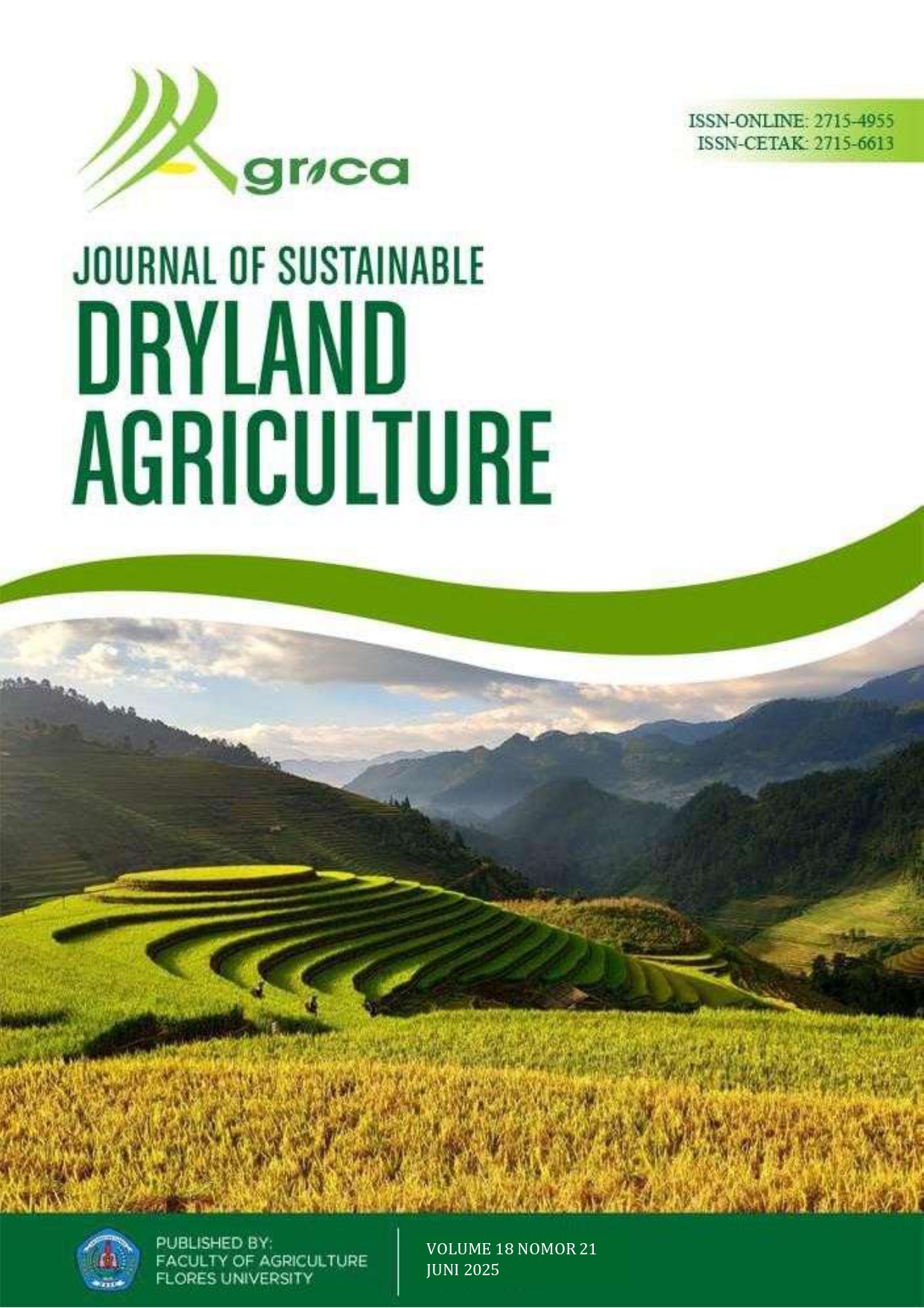STUDI KANDUNGAN CAPSAISIN CABAI RAWIT (Capsicum frutescens L.) AKIBAT PEMBERIAN MUTAGEN KIMIA EMS (ETHYL METHANE SULFONATE)
DOI:
https://doi.org/10.37478/agr.v18i1.5678Abstract
Chili pepper (Capsicum frutescens L.) is an important horticultural commodity in Indonesia with high economic value, primarily due to its capsaicin content, which provides its distinctive pungency and health benefits. This study aimed to evaluate the effect of Ethyl Methane Sulfonate (EMS) as a chemical mutagen agent on capsaicin content in the leaves and stems of three local chili pepper genotypes. The research was conducted using a two-factor Completely Randomized Design (CRD) with three replications, consisting of EMS concentrations (0.00%, 0.01%, 0.02%, and 0.04%) and three chili pepper genotypes. Mutation treatment was carried out by soaking seeds in EMS solution for six hours. Capsaicin content was analyzed using spectrophotometry at a wavelength of 280 nm. The results showed that EMS treatment had no significant effect on capsaicin content in either leaves or stems across all genotypes. However, there was a tendency for increased capsaicin content in certain treatment combinations, particularly at EMS concentrations of 0.01%. This suggests that EMS treatment at specific concentrations may induce physiological changes associated with capsaicin production.
Downloads
Keywords:
Chili Pepper, Capsaicin, EMS, Chemical MutationReferences
Abdul, S. C. M. 2007. “Studies on Chemical Mutagenesis in Varieties Ujwala and Co 1 of Capsicum Annum L.” University of Calicut.
Aziz, Muhammad Abdul, Sri Wahyuni, Fenny Martha Dwivanny, and Rizkita Rachmi ESYANTI. 2021. “Peningkatan Kadar Capsaicin Tanaman Capsicum Annuum Cv. Lado Pada Kondisi Kekeringan Menggunakan Kitosan.” E-Journal Menara Perkebunan 89(2). doi: 10.22302/iribb.jur.mp.v89i2.423.
Bahar, Bilge, and Mahinur S. Akkaya. 2009. “Effects of EMS Treatment on the Seed Germination in Wheat.” Journal of Applied Biological Sciences 3(1):59–64.
Barbero, Gerardo F., Aurora G. Ruiz, Ali Liazid, Miguel Palma, Jesús C. Vera, and Carmelo G. Barroso. 2014. “Evolution of Total and Individual Capsaicinoids in Peppers during Ripening of the Cayenne Pepper Plant (Capsicum Annuum L.).” Food Chemistry 153:200–206. doi: 10.1016/j.foodchem.2013.12.068.
Chen, Liuzhu, Liu Duan, Minghui Sun, Zhuo Yang, Hongyu Li, Keming Hu, Hong Yang, and Li Liu. 2023. “Current Trends and Insights on EMS Mutagenesis Application to Studies on Plant Abiotic Stress Tolerance and Development.” Frontiers in Plant Science 13. doi: 10.3389/fpls.2022.1052569.
Cisnerospineda, O., L. Torrestapia, L. Gutierrezpacheco, F. Contrerasmartin, T. Gonzalezestrada, And S. Perazasanchez. 2007. “Capsaicinoids Quantification in Chili Peppers Cultivated in the State of Yucatan, Mexico.” Food Chemistry 104(4):1755–60. doi: 10.1016/j.foodchem.2006.10.076.
Hasan, Nazarul, Sana Choudhary, Mehjabeen Jahan, Nidhi Sharma, and Neha Naaz. 2022. “Mutagenic Potential of Cadmium Nitrate [Cd(NO3)2] and Ethyl-Methane Sulphonate [EMS] in Quantitative and Cyto-Physiological Characters of Capsicum Annum L. Cultivars.” Ecological Genetics and Genomics 22:100110. doi: 10.1016/j.egg.2021.100110.
Hasan, N., Choudhary, S., Naaz, N., Sharma, N., Farooqui, S. A., Budakoti, M., & Joshi, D. C. 2024. Identification and characterization of Capsicum mutants using, biochemical, physiological, and single sequence repeat (SSR) markers. Journal of Genetic Engineering and Biotechnology, 22(4), 100447. https://doi.org/10.1016/j.jgeb.2024.100447
Jabeen, Nyla, and . Bushra Mirza. 2002. “Ethyl Methane Sulfonate Enhances Genetic Variability in Capsicum Annuum.” Asian Journal of Plant Sciences 1(4):425–28. doi: 10.3923/ajps.2002.425.428.
Kumar, Nitish. 2023. Plant Mutagenesis and Crop Improvement. New York: CRC Press.
Laskar, R. A., Chaudhary, C., Khan, S., & Chandra, A. 2018. Induction of mutagenized tomato populations for investigation on agronomic traits and mutant phenotyping. Journal of the Saudi Society of Agricultural Sciences, 17(1), 51–60. https://doi.org/10.1016/j.jssas.2016.01.002
Lidya Yuniati, M. Ridho Anugrah, Siti Hopipah, Nopia Himayatul, and Zuhdiyah Matienatul Iemaaniah. 2024. “Pemberdayaan Masyarakat Melalui Penyuluhan Pengaruh Teknik Irigasi Tetes Terhadap Budidaya Tanaman Cabai Rawit (Capsicum Frutescens L.) Di Desa Kuta Lombok Tengah.” Jurnal SIAR ILMUWAN TANI 5(1):14–21. doi: 10.29303/jsit.v5i1.129.
Mahpara, Shahzadi, Lariab Fatima, Ammara Gul, Rehmat Ullah, Muhammad Muneer, Muhammad Ashraf Bhatti, Javed Iqbal, Affan Ahmed, Tehseen Fatima, Muhammad Usman Ijaz, Sulaiman Ali Alharbi, Wafa A. Alrasheed, Muhammad Ihsan Ullah, Abdul Rauf, Muhammad Waqar Nasir, and Hesham Ali El Enshasy. 2023. “Exploring the Efficiency of Ethyl Methane Sulfonate (EMS) and Sodium Azide (SA) to Induce Mutation in Chili (Capsicum Annuum L.) Germplasm.” Journal of King Saud University - Science 35(2):102507. doi: 10.1016/j.jksus.2022.102507.
Nikalje, Ganesh C., Vikas Y. Patade, Shriram J. Mirajkar, and Penna Suprasanna. 2024. “Applications of Radiations and Mutagenesis for the Enhancement of Plant Secondary Metabolites.” Pp. 507–25 in Biotechnological Production of Bioactive Phytochemicals of Medicinal Value. Elsevier.
Omosum, Garuba., Ekundayo, E. O., Okoro, I. A., Ojimelukwe, P. C., Egbucha, K. C., Akanwa, F. E. 2021. “Preliminary Study on the Effect of Different Concentrations of EMS on Two Pigeon Pea (Cajanus cajan L. Millsp.) Accessions.” African Scientist 22(2):58-65
Rodriguez-Uribe, Laura, Luz Hernandez, James P. Kilcrease, Stephanie Walker, and Mary A. O’Connell. 2014. “Capsaicinoid and Carotenoid Composition and Genetic Diversity of Kas I and Ccs in New Mexican Capsicum Annuum L. Landraces.” HortScience 49(11):1370–75. doi: 10.21273/HORTSCI.49.11.1370.
Rustini, Ni Kadek Dewi, and Made Pharmawati. 2014a. “Aksi Ethyl Methane Sulphonate Terhadap Munculnya Bibit Dan Pertumbuhan Cabai Rawit(Capsicum Frutescens L.) (Ethyl Methane Sulphonate Action on Seed Emergence and Growth of (Capsicum Frutecens L.)).” BIOSLOGOS 4(1).
Rustini, Ni Kadek Dewi, and Made Pharmawati. 2014b. “Aksi Ethyl Methane Sulphonate Terhadap Munculnya Bibit Dan Pertumbuhan Cabai Rawit(Capsicum Frutescens L.) (Ethyl Methane Sulphonate Action on Seed Emergence and Growth of (Capsicum Frutecens L.)).” Jurnal Bios Logos 4(1). doi: 10.35799/jbl.4.1.2014.4836.
Samadi, Negin, Mohammad Reza Naghavi, Natalia Moratalla-López, Gonzalo L. Alonso, and Majid Shokrpour. 2022. “Morphological, Molecular and Phytochemical Variations Induced by Colchicine and EMS Chemical Mutagens in Crocus Sativus L.” Food Chemistry: Molecular Sciences 4:100086. doi: 10.1016/j.fochms.2022.100086.
Tania, Devi, Siti Marwiyah, and Surjono Hadi Sutjahjo. 2023. “Keragaman Karakter Agronomi Populasi M2 Kacang Hijau (Vigna Radiata L. Wilczek).” Buletin Agrohorti 11(2):175–84. doi: 10.29244/agrob.v11i2.47125.
Viktorija, Maksimova, Koleva G. Liljana, Ruskovska Tatjana, Cvetanovska Ana, and Gulaboski Rubin. 2014. “Antioxidative Effect of Capsicum Oleoresins Compared with Pure Capsaicin.” Journal Of Pharmacy 4(11):44–48.
Zam, Wahyuni, Ilyas Ilyas, and Syatrawati Syatrawati. 2019. “Penerapan Teknologi Pascapanen Untuk Meningkatkan Nilai Jual Cabai Di Tanatoraja.” Jurnal Dedikasi Masyarakat 2(2):92. doi: 10.31850/jdm.v2i2.407
Downloads
Published
How to Cite
Issue
Section
License
Copyright (c) 2025 Putri Nur Arrufitasari, Galih El Fikri, Aline Sisi Handini, Oentari Prilaningrum Sutanto, Careca Sepdihan Rahmat Hidayatullah

This work is licensed under a Creative Commons Attribution-ShareAlike 4.0 International License.














